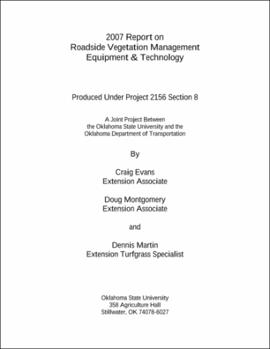| dc.description.abstract | The objective of this report is to provide Oklahoma Department of Transportation (ODOT) personnel with recommendations concerning the utilization of new technologies and/or adaptations of existing technology that will enable vegetation managers to comply with ODOT抯 need to provide safe travel corridors for Oklahoma抯 motoring public. The year 2007 was a banner one for Oklahoma in that the state celebrated its one-hundredth year of statehood. ODOT was heavily involved in an 揺levated level of service� that increased the level of maintenance on both rural roadsides and heavily traveled corridors funneling visitors into Oklahoma. The term 揺levated level of service� was introduced by the Director of The Department of Transportation, Mr. Gary Ridley. The centennial celebration involved increases in the number of roadside acres treated with herbicides (see 2007 Annual ODOT Herbicide Program Report) so as to improve the aesthetic appearance of travel corridors and staging areas for major celebration events. In meetings across the state, several divisions with high populations and state highways traversing major Oklahoma metropolitan areas (Tulsa Co. and Oklahoma Co.) expressed interest in making herbicide applications from 揻ence to fence�. This would mean a broadcast herbicide application extending from the hard highway surface edge to the adjoining non-ODOT property (covering both the safety zone and transition zone). Traditionally, ODOT has counted on the untreated transition zone as a buffer to catch any herbicide particle drift before it reaches and is deposited on adjacent property. Additionally, the transition zone has served as a repository for herbicide-sensitive native forbs that do not have a good fit in the safety zone but are considered suitable and desirable outside of the safety zone. Forbs are annual or perennial non-woody broadleaf plants that are not sedges, grasses or rushes. Many of these forbs including what the public would call 搉ative Oklahoma wildflowers.� While this broadcast herbicide treatment approach to the transition zone may be viewed as a way to increase aesthetic appearances and decrease the amount of weed pressure, the close proximity to adjacent property means that applicators need to pay special attention to wind speed and temperature inversion conditions. On-site and instantaneous measurement of wind speed, wind direction and air temperature can serve as a means of dispelling claims against ODOT if complainants argue that ODOT抯 application drifted onto their property. Currently, the Oklahoma Department of Agriculture, Food and Forestry (ODAFF) does not require that records reflect wind speeds at the time of herbicide application. However, it has been the practice of ODOT to keep these records so as to provide confirmation that wind conditions were within spray application parameters set by the herbicide manufacturer. Currently, most ODOT抯 spray crews utilize a hand-held Dwyer wind meter (Dwyer Interments, Inc., Michigan City, Ind. 46360, Pat. No. 2993374) that is very economical (Forestry Supply, Inc.) costing approximately $14.00 per unit (Figure 1.). While this device is accurate, they require the spray rig operator to manually measure wind speeds by exiting the vehicle and exposing the device to wind currents, then physically recording the measured wind speed on hand-written spray record sheets (Figure 2.). One of the drawbacks to the hand-held unit is that the spray rig operator may not be aware of wind speed changes as well as wind direction changes. As part of ODOT抯 contract with the Oklahoma State University Roadside Vegetation Management (OSU RVM) program, OSU personnel are contracted to attend the annual National Roadside Vegetation Management Association (NRVMA) meetings to gather information on technology that may have application to ODOT抯 IRVM (Integrated Roadside Vegetation Management) program. This year (October 2-4, 2007) the meetings were held in Charlotte, N.C., and contact was made with Nathan Cross, Technology Representative for Spectrum Technologies, Inc. This company manufactures and distributes leading-edge measurement information technology to the agricultural markets worldwide. One of Spectrum Technologies, Inc. products that may have application to ODOT抯 spray program is the WatchDog Sprayer Station (Figure 3.). | |
